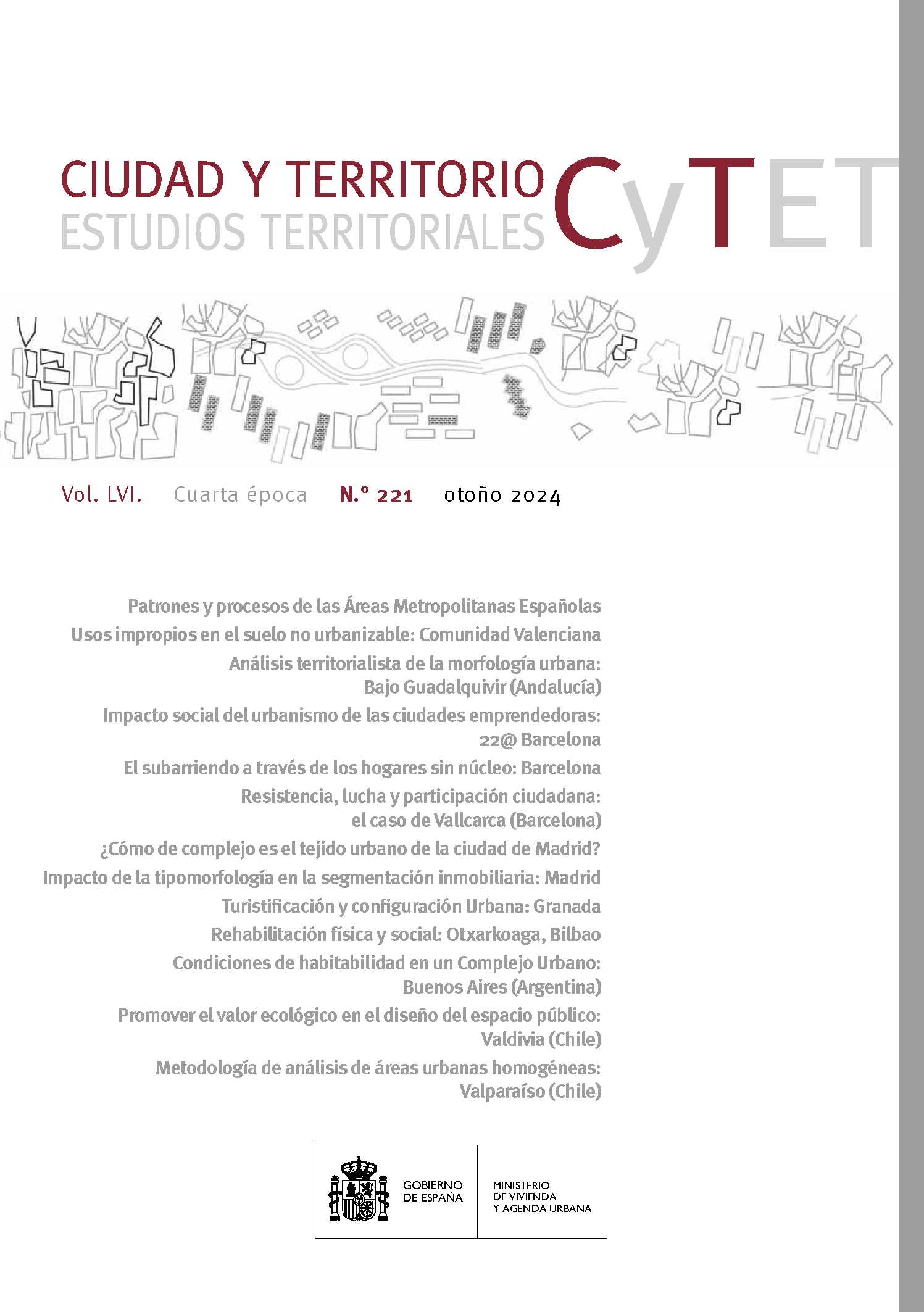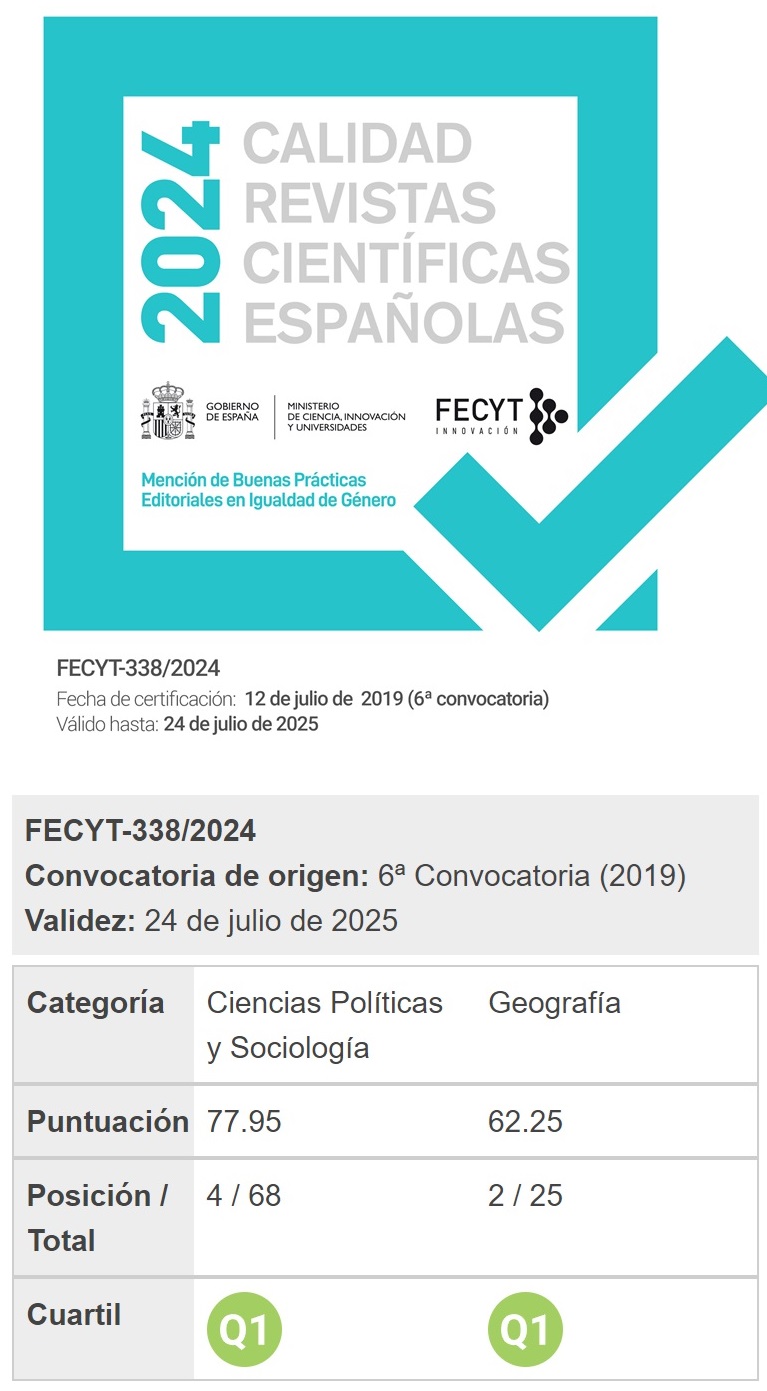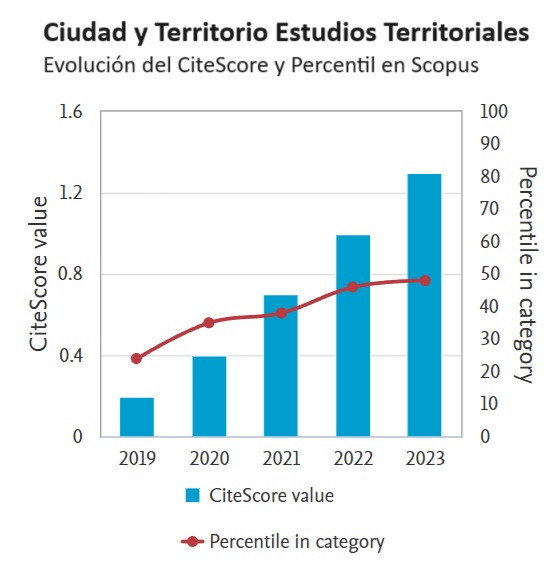Regeneración urbana en barrios vulnerables: tensiones entre lo físico y lo social en el caso de Otxarkoaga, Bilbao
DOI:
https://doi.org/10.37230/CyTET.2024.221.10Palabras clave:
Regeneración urbana, Rehabilitación urbana, Barrios vulnerables, Enfoques cualitativosResumen
Este artículo se propone como punto de partida de un proyecto competitivo retomando algunas de las contribuciones más relevantes de un trabajo realizado sobre políticas de regeneración urbana en barrios vulnerables de Barcelona y Bilbao entre 2019 y 2022. El artículo se plantea recuperar una serie de entrevistas a técnicos municipales de urbanismo y a representantes de entidades locales (asociación de comerciantes, asociación del pueblo gitano y asociación vecinal) del barrio de Otxarkoaga en Bilbao. El objetivo es presentar algunas conclusiones extraídas del análisis cualitativo en torno a las dimensiones de la vulnerabilidad urbana desde la perspectiva de los actores entrevistados, vinculadas a las maneras de vivir y representar los procesos de segregación, así como las necesidades, dificultades y demandas de intervención en la rehabilitación de los edificios, y la regeneración urbana de Otxarkoaga.
Descargas
Citas
ALGUACIL GÓMEZ, J. & CAMACHO GUTIÉRREZ, J. & HERNÁNDEZ AJA, A. (2014): La vulnerabilidad urbana en España. Identificación y evolución de los barrios vulnerables. Empiria 27. https://doi.org/10.5944/empiria.27.2014.10863
ARIAS GOYTRE, F. (2001): La desigualdad urbana en España. Ciudades para un futuro más sostenible (Biblioteca CF+S). http://habitat.aq.upm.es/
AYUNTAMIENTO DE BILBAO (2019): Plan General de Ordenación Urbana, PGOU. https://www.bilbao.eus/cs/Satellitec=Page&cid=1279215608453&language=es&pageid=1279215608453&pagename=Bilbaonet%2FPage%2FBIO_Listado
AYUNTAMIENTO DE BILBAO (2019): (2023): Estudio de Percepción de Seguridad y Victimización en Bilbao 2022.https://www.bilbao.eus/cs/Satellitec=BIO_Noticia_FA&cid=1279224805971&language=es&pageid=3012590127&pagename=Bilbaonet%2FBIO_Noticia_FA%2FBIO_Noticia
BAKAIKOA, J. (2008): Entrando en contacto con la etnia gitana. Itxaropena 84. https://otxarkoaga.es/2008/03/20/entrando-en-contacto-con-la-etnia-gitana/
BARAÑANO, M. (2021): Los hogares como espacios de arraigo y sus transformaciones en un contexto global. Encrucijadas. Revista Crítica de Ciencias Sociales, 21(1), 1-29. https://eprints.ucm.es/id/eprint/70463/1/LosHogaresComoEspaciosDeArraigoYSusTransformacione-7974532.pdf
BILBAO LARRONDO, L. (2017): Bilbao: el Plan de Urgencia Social y el Polígono de Otxarkoaga (1959-1964). Kobie, 20, 71-100.
BLUNT, A. & DOWLING, R. (2006): Home. Routledge: London. https://doi.org/10.4324/9780203401354
BOTANA, C. (2020): La promoción pública de segregación urbana. Crítica Urbana (12). https://criticaurbana.com/wp-content/uploads/2020/05/CU12.-Cristina-Botana.pdf
BOURDIEU, P & PASSERON, J.C. (1970): La reproducción. París, Francia, Minuit.
CAPEL, H. (2002): La morfología de las ciudades. Barcelona, España, Ediciones del Serbal.
CHECA, J. C. (2006): La diferenciación residencial. Conceptos y modelos empíricos para su comprensión. Granada, España, Editorial Comares.
CHECA, J. C. & ARJONA, A. (2008): Procesos de segregación residencial en la población gitana. El caso Almeriense. Revista de estudios regionales, 85, 173-196. https://www.redalyc.org/pdf/755/75511762007.pdf
CRESPI-VALLBONA, M. & LÓPEZ VILLANUEVA, C. (2022): La resistencia ciudadana en los barrios turistificados. Un análisis post-pandémico [Comunicación en Congreso]. XVI Coloquio de Geografía Urbana. Málaga-Melilla. https://www.researchgate.net/profile/Lluis-Frago-Clols/publication/361763872_La_emergencia_comercial_y_la_ciudad_de_los_15_minutos_utopias_y_realidades_del_proyecto_superilla_Barcelona/links/62c40dae9a17145f5f468a53/La-emergencia-comercial-y-la-ciudad-de-los-15-minutos-utopias-y-realidades-del-proyecto-superilla-Barcelona.pdf#page=214
ENGELS, F. (1976): La Situación de la clase obrera en Inglaterra. Madrid, España, Akal.
FERNÁNDEZ ÁLVAREZ, L. (2023): El valor formal en la rehabilitación de la vivienda social de los 60. [Trabajo Fin de Grado, E.T.S. Arquitectura (UPM)] https://oa.upm.es/72656/1/TFG_Ene23_Fernandez_Alvarez_Laura.pdf
FERNÁNDEZ-ARAGÓN, I. (2018): Pautas de localización socio-residencial de la población inmigrante extranjera en el gran Bilbao. [Tesis Doctoral, UPV]. http://hdl.handle.net/10810/34587
FERNÁNDEZ CARBAJAL, A. (2003): La política de vivienda en España durante el franquismo. Ciudad y Territorio, XXXV (138), 639-654.
GARCÍA ABAD, R. (2012): Migraciones en familia a la Bizkaia de la primera industrialización (1877-1935). Vasconia, 38, 711-740.
GURRUTXAGA, A. (1981): Plan Especial de Reforma interior y saneamiento del barrio de Otxarkoaga en Bilbao (Vizcaya). Madrid, España, Ministerio de Fomento.
HERNÁNDEZ AJA, A. (2015): Atlas de Barrios Vulnerables de España: 12 Ciudades 1991/2001/ 2006. Instituto Juan de Herrera, Madrid. https://oa.upm.es/34999/
HERNÁNDEZ AJA, A & ALGUACIL GÓMEZ, J. & MEDINA DEL RÍO, M. & MORENO CABALLERO, C. (1997): La ciudad de los ciudadanos. Ministerio de Fomento, Madrid. http://habitat.aq.upm.es/aciudad/aciudad.pdf
HERNÁNDEZ AJA, A & MATESANZ PARELLADA. Á. & RODRÍGUEZ-SUÁREZ, I. & GARCÍA MADRUGA, C. (2015): Evolución de las políticas de rehabilitación en Áreas de Rehabilitación Integrada en España (1978-2012). Informes de la Construcción, 67, 1-15. https://doi.org/10.3989/ic.14.057
HERZER, H. & RODRÍGUEZ, C. (2000): Sociología y ciudad: los desafíos actuales. Ciencias Sociales, FCS – UBA, 44, 1-2.
ÍÑIGUEZ, I. (2006): Análisis del discurso. Manual para las ciencias sociales (2ª ed.) Barcelona: UOC.
JACOBS, J. (2011): Muerte y vida en las grandes ciudades. Madrid, España, Capitán Swing.
LEFEBVRE, H. (2017): El derecho a la ciudad. Madrid, España, Capitán Swing.
LÓPEZ SIMÓN, I. (2015): Otxarkoaga, un caso de Poblado Dirigido en Bilbao. De la chabola a la marginación urbana en el desarrollismo franquista. Historia Contemporánea, 52, 309-345. DOI: https://doi.org/10.1387/hc.15746
MARMOLEJO-DUARTE, C. & BIERE-ARENAS, R. & SPAIRANI-BERRIO, S. & CRESPO-SÁNCHEZ, E. (2022): Las one-stop-shops como modelo emergente en la gestión de la rehabilitación energética en españa. Ciudad y Territorio Estudios Territoriales, 54(213), 593–620. https://doi.org/10.37230/CyTET.2022.213.5
MARTÍN-CONSUEGRA, F. & ALONSO, C. & FRUTOS, B. (2015): La regeneración urbana integrada y la declaración de Toledo. Informes de la Construcción, 67(EXTRA-1): nt002, doi: http://dx.doi.org/10.3989/ic.14.084
MARTÍNEZ CALLEJO, J. (2009): Bilbao. Desarrollos urbanos. Ciudad y forma. Vitoria-Gasteiz. España, Servicio Central de Publicaciones del Gobierno Vasco.
MARX, K. (1980): Teorías sobre la plusvalía. En K. Marx y F. Engels (Eds.), Obras fundamentales. Ciudad de México, México, Fondo de Cultura Económica.
MATESANZ PARELLADA, A. (2016): Políticas Urbanas y Vulnerabilidad. [Tesis doctoral, Universidad Politécnica de Madrid].https://oa.upm.es/44893/1/ANGELA_MATESANZ_PARELLADA.pdf
MESA, S. (2019): Silencio administrativo. La pobreza en el laberinto burocrático. Barcelona, España, Cuadernos Anagrama.
MONTANER, J. M. (2019): Cap a una nova cultura de la rehabilitació a Barcelona. Qüestions d’Habitatge, 23, 8-19. https://bcnroc.ajuntament.barcelona.cat/jspui/bitstream/11703/118796/1/qh23_web.pdf
MUMFORD, L (2014): La ciudad en la historia. Logroño, España, Pepitas de Calabaza.
PARK, R. & BURGESS, E. (1921): Introduction to the Science of Sociology. Chicago, Estados Unidos, University of Chicago Press.
PHILPOTT, T. L. (1978): The Slum and the Ghetto: Neighborhood Deterioration and Middle Class Reform, Chicago, 1880–1930. Chicago, Estados Unidos, University of Chicago Press.
PIASEK, G. & VIMA GRAU, S. & GARCIA-ALMIRALL, P. (2020): Tendencias y omisiones de las políticas de rehabilitación urbana: lo que la política no mira, ¿no existe? [Comunicación en congreso]. IV Congreso ISUF-H: Metrópolis en recomposición: prospectivas proyectuales en el Siglo XXI: Forma urbis y territorios metropolitanos. Barcelona. http://hdl.handle.net/2117/328580
PÍREZ, P. (1995): Actores sociales y gestión de la ciudad. Revista Ciudades, 28. https://www.researchgate.net/publication/274313532_Actores_sociales_y_gestion_de_la_ciudad
RAVETLLAT MIRA, P. J. & DÍAZ GÓMEZ, C. & CORNADÓ BARDÓN, C. & VIMA GRAU, S. (2019): La millora de les condicions d'habitabilitat en els grans conjunts residencials de l'Àrea Metropolitana de Barcelona. Llibre, Iniciativa Digital Politècnica. Oficina de Publicacions Acadèmiques Digitals de la UPC. Barcelona, España, Ediciones UPC. http://hdl.handle.net/2117/178642
RIBA CAMPOS, C.E. (2010): Tècniques d’anàlisi de dades qualitatives. Recursos Educativos UOC Abiertos. http://hdl.handle.net/10609/52441
RUBIO DEL VAL, J. (2011): Rehabilitación Urbana en España (1989-2010). Barreras actuales y sugerencias para su eliminación. Informes de la Construcción, 63, 5-20. https://doi.org/10.3989/ic.11.060
SÁNCHEZ VIDAL, A. (2001): Sense of community: Measurement and internal structure; An empirical study. International Journal of Social Psychology, 16(2), 157-175. https://doi.org/10.1174/021347401317351116
SANTAS TORRES, A. (2007): Urbanismo y vivienda en Bilbao. Veinte años de posguerra. Bilbao, COAVN Delegación de Bizkaia.
SHAW, C. R. (1952): Brothers in Crime. Philadelphia, Estados Unidos, Albert Saifer.
UCEDA NAVAS, P. (2017): La ciudad desequilibrada. El derecho a la ciudad en los barrios vulnerables de Madrid [Tesis doctoral, Universidad Complutense de Madrid, Madrid]. https://eprints.ucm.es/id/eprint/42546/1/T38942.pdf
UCEDA NAVAS, P. & DOMÍNGUEZ PÉREZ, M. (2023): Reequilibrando los espacios urbanos. Derecho a la ciudad y participación ciudadana en los barrios vulnerables de Madrid. Revista Española de Investigaciones sociológicas, 180, 117-134.
ULLÁN DE LA ROSA, F. J. (2014): Sociología urbana: de Marx y Engels a las escuelas posmodernas. Madrid, España, CIS.
VARELA, M. & ETXEPARE, L. (2020): Medio siglo largo del Polígono Dirigido de Ocharcoaga (1959-1964). Luces y sombras de un barrio desarrollista. Ciudad y Territorio, LII (205), 559-574.
WACQUANT, L. (2010): Las dos caras de gueto. Ensayos sobre la marginalización y penalización. Buenos Aires, Argentina, Siglo veintiuno.
YORY, C. (2007): Del espacio ocupado al lugar habitado: una aproximación al concepto de topofilia. Serie Ciudad y Hábitat, 12, 47-64. https://www.academia.edu/42872187/DEL_ESPACIO_OCUPADO_AL_LUGAR_HABITADO_Una_aproximaci%C3%B3n_al_concepto_de_topofilia
Publicado
Cómo citar
Número
Sección
Licencia
Derechos de autor 2024 Gonzalo Piasek

Esta obra está bajo una licencia internacional Creative Commons Atribución-NoComercial-SinDerivadas 4.0.
Sin perjuicio de lo dispuesto en la legislación vigente sobre Propiedad Intelectual, y conforme a la misma, el/la los/las autor/a/es/as que publiquen en CyTET cede/n a título gratuito, de modo no exclusivo y sin límite temporal al Ministerio de Transportes, Movilidad y Agenda Urbana los derechos para difundir, reproducir, comunicar y distribuir en cualquier formato actual o futuro, en papel o electrónico, la versión original o derivada de su obra bajo licencia de Creative Commons Reconocimiento-NoComercial-SinObraDerivada 4.0 Internacional (CC BY-NC-ND 4.0), así como para incluir o ceder a terceros la inclusión de su contenido en índices, repositorios y bases de datos nacionales e internacionales, con referencia y reconocimiento en todo caso de la autoría del mismo.
Además, al realizar el envío, el/la los/las autor/a/es/as declara/n que se trata de un trabajo original en el que se reconocen las fuentes que han sido utilizadas en su estudio, comprometiéndose a respetar la evidencia científica y a no modificar los datos originales para verificar o refutar una hipótesis de partida; que el contenido esencial del mismo no ha sido publicado previamente ni se publicará en ninguna otra obra o revista mientras esté en proceso de evaluación en la revista CyTET; y que no se ha remitido simultáneamente a otra publicación.
Los autores deben firmar un Formulario de Cesión de Derechos, que les será enviado desde la Secretaría de CyTET una vez se acepte su artículo para ser publicado.
Con el objetivo de favorecer la difusión del conocimiento, CyTET se adhiere al movimiento de revistas de Open Access (OA) y entrega la totalidad de sus contenidos a diversos índices, repositorios y bases de datos nacionales e internacionales bajo este protocolo; por tanto, la remisión de un trabajo para ser publicado en la revista presupone la aceptación explícita por parte del autor/a de este método de distribución.
Se anima a las/os autoras/es a reproducir y alojar sus trabajos publicados en CyTET en repositorios institucionales, páginas web, etc. con la intención de contribuir a la mejora de la transferencia del conocimiento y de la citación de dichos trabajos.








 Enlace a CyTET en Linkedin
Enlace a CyTET en Linkedin